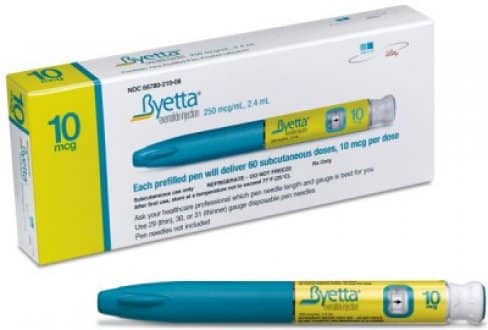What is Byetta?
Byetta insulin, delivered by subcutaneous injection, is a medication that is indicated for the improvement of glycemic control in patients with type 2 diabetes mellitus. It is used in combination with metformin and/or a sulfonylurea medication.
Medications in the Byetta drug class are suitable for patients who experience insufficient glycemic control when taking the maximum dosage of sulfonylureas and/or metformin, in addition to a healthy diet and abundant exercise.
Who makes it?
Byetta is manufactued by Amylin Pharmaceuticals.
What is this medication used for?
Byetta medication is combined with insulin glargine therapy (with or without additional metformin) for the purposes of improving glycemic control in patients with type 2 diabetes mellitus, when diet and exercise alone provide insufficient glycemic control.
How does the drug work?
Byetta has a complicated dosing regimen and patients must consult with their physicians. The drug should be administered at any time within a 60-minute window before the morning and evening meals. The two main meals of the day must be taken at least 6 hours apart. This medication must not be taken after a meal.
Byetta should be initiated at 5 µg per dose, administered twice daily in patients with type 2 diabetes mellitus who are currently undertaking metformin therapy, treatment with a sulfonylurea or a combination of both. Based on the clinical response of the patient, the dosage may be increased to 10 µg twice daily. That is the maximum dosage. If no improvement in blood glucose levels is detected after 3 to 4 months of therapy at 10 µg, alternative therapies to Byetta should be considered.
Byetta side effects
The most commonly observed side effects, as observed during a large-scale clinical trial, were gastrointestinal, including vomiting and diarrhea. Byetta is generally well-tolerated and users should be aware that hypoglycemia can occur with use.
Common side effects
- Nausea
- Vomiting
- Diarrhea
Severe side effects
- Hypoglycemia
- Ear pain
- Ocular disorders
Dosage
Considering when to take Byetta injection, it is typically administered twice per day, shortly before meals. Dosages of the drug should be spaced about 6 hours apart. This medicine must not be taken after meals. The usual starting dose of Byetta is 5 µg administered twice per day, with a maximum dose of 10 µg per day. The drug is available as a pre-filled pen.


